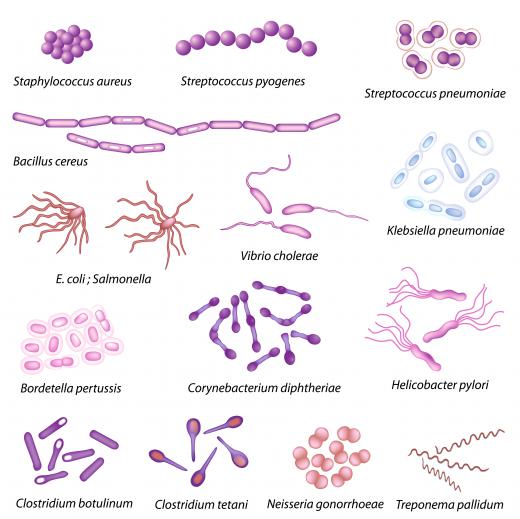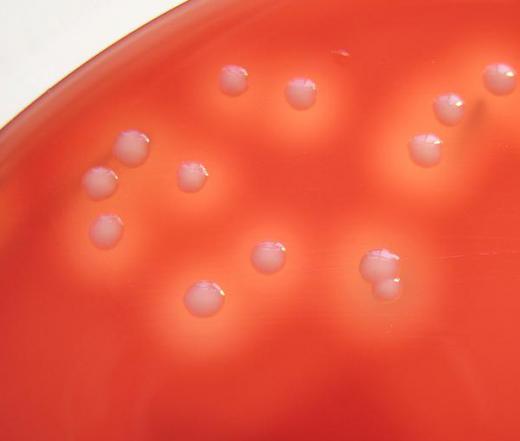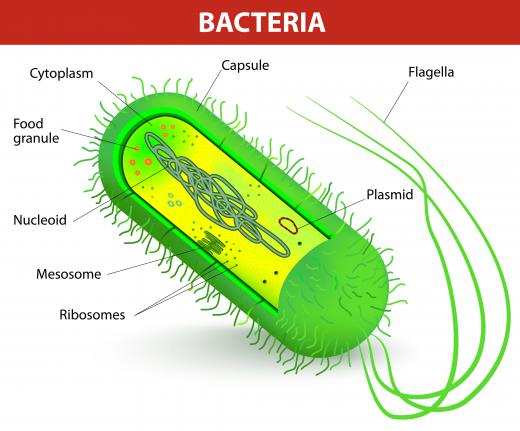What is Coccus?
The word “coccus” has a couple of different meanings in biology, but it most commonly refers to a type of bacteria that is spherical or slightly oval in shape. In this application, the plural term used to describe entire bacterial chains or infections is cocci, whereas a single coccus bacterium is called a monococcus. There are many different strains and species in this broad family. Some benefit life, either by helping keep cell balance or warding off other infections, while others can be quite harmful. In most cases the shape of the bacteria is useful for classification and evolutionary purposes but doesn’t say much about how it will perform or what it does. The bacteria’s individual coding and composition more commonly dictate these things.
Physical Characteristics

Cocci are some of the smallest bacteria in existence. Their diameters typically average 0.5 to 1.0 micrometers, and they are usually shaped like a flat, elongated oval. This shape also gives them the largest surface area in relation to their size, which enables them to more efficiently take up nutrients from the environment. In many cases this means that the bacteria are hardier and more likely to survive in harsh environments, but sometimes it can also be a downside. Greater surface area can mean that the bacteria is more susceptible to absorbing harmful substances.
Reproduction

When bacteria are reproducing, monococci are formed only when a new cell splits completely from its parent cell. Some monococci are usually present in any species of bacteria with this shape, but it is quite common for them to form groups of two or more cells.
It’s often the case in these sorts of splits that there isn’t a complete separation between the parent bacterium and the newly formed one. This can lead to a couple of different formations, though no matter the end result it’s important to note that each individual cell retains its original spherical shape. The simplest formation is known as diplococcus, in which two cells remain attached to each other. Neisseria is a genus of bacteria that often forms these pairs of cells. Many species of Neisseria are found in healthy human throats, but the bacteria that cause meningitis also belong to this genus.
Chains and Large Groupings

Cocci bacteria can also form larger groups, including groups of four, eight, ten, or more. Groups of four are known as tetrads, while groups of eight are called sarcinae. Many bacteria forming a clump is typically called a staphylococcus, which is also the name of a specific genus of bacteria that most often form in this arrangement. The formal genus Staphylococcus includes many species that are commonly found on human skin, as well as some bacteria that reside in the soil. In most cases it also contains Staphylococcus aureus, which can cause staph infections; these strains are also often resistant to antibiotics.
Common Species

Multiple chains of the bacteria are generally called streptococci, and many bacteria that take on this shape are found in the genus Streptococcus. A good percentage of these strains are normal throat and nose bacteria, but the species that cause pneumonia, strep throat, and scarlet fever are also in this group. Enterococcus and Lactococcus species produce lactic acid, a substance that is necessary to create fermented dairy products such as yogurt. Lactococci in particular are often used in the dairy industry both as a way to help produce dairy products and to assist consumers in their digestion.
Alternative Definitions

The word “coccus” also has a couple of other meanings in the scientific realm that are unrelated to bacteria. A group of tropical insects that are small, flat, and round carry the name, for instance; these feed primarily on the bark of citrus trees and coffee plants, which makes them a well-known pest to growers and agriculturalists in many parts of the world. In botany the term can also be applied to a single seed that splits apart from a multi-lobed or multi-seeded mass, like a berry or other fruit. It’s usually the case that these seeds also have the familiar flattened oval shape.
AS FEATURED ON:
AS FEATURED ON:















Discussion Comments
I guess we all have experience with coccus bacteria without even knowing it. There are few people who get through their entire lives without developing strep throat at least ponce. Me personally, I have probably had it a dozen times in my life.
Its crazy to think of how ubiquitous this bacteria is. In every human population on every part of the earth there is streptococcus bacteria that produces just about the exact same reaction in all humans. It is more common than any plant or animal on the face of the earth.
I know that being a scientist is hard and that it takes years of training and study. It seems to me that so much of this mental effort must be but in the service of simply learning the various terms. I could not believe how many different terms were referenced in this article. Anytime something exists in just a slightly different formation is has to be given a new name. Scientists must have to keep huge dictionaries on their desks just to keep all the various words straight.
Its interesting how often basic principles carry through lots of different things in nature. For instance, the coccus described in this article has a round flat shape giving it the most possible surface area. This is a biological advantage because it allows the bacteria to take up more nutrients.
The leaves on trees operate according to the same principle. They are very thing but have lots of surface area in order to soak up the maximum amount of sunlight. I'm sure there are lots of other instances in nature when this principle holds true.
Post your comments